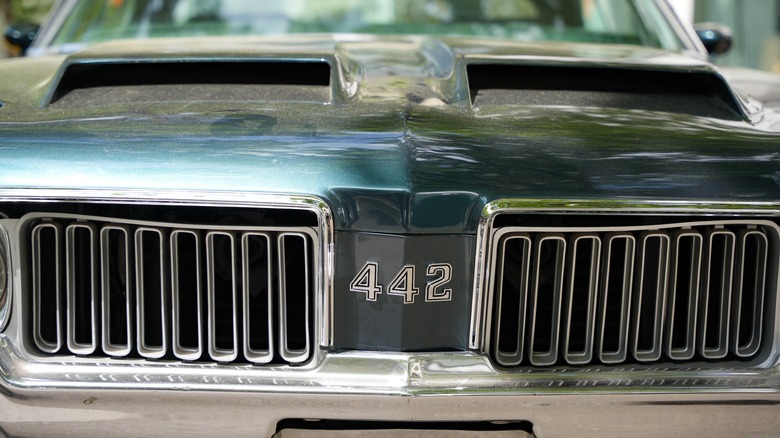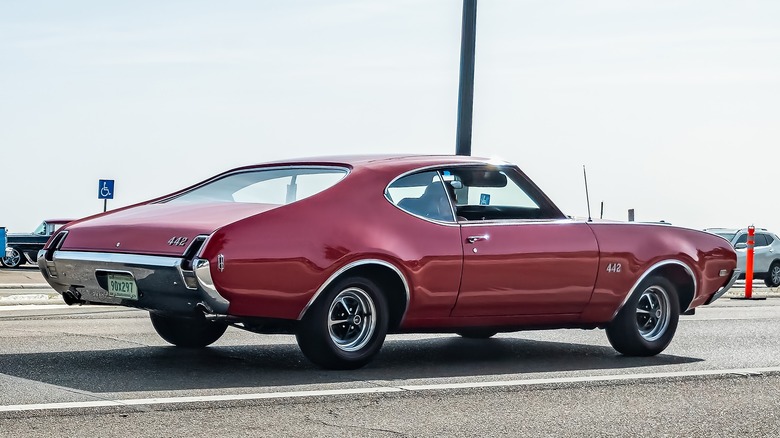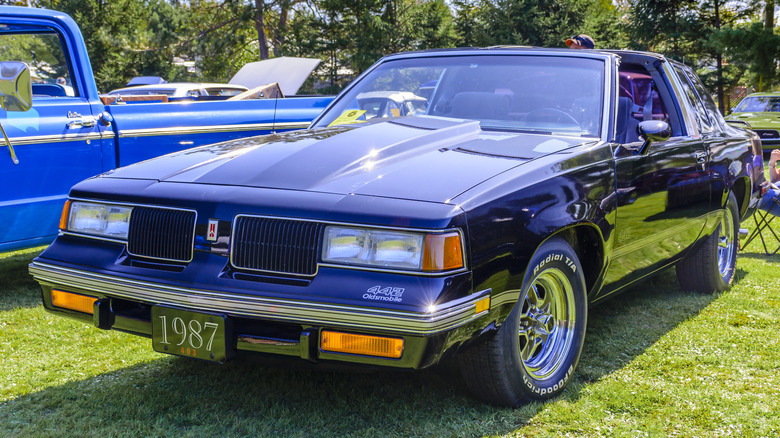What Does '442' Mean On The Oldsmobile 442?
Though it's now been more than 20 years since the last Oldsmobile ever made rolled off the assembly line, the fallen General Motors brand continues to be held in high regard by classic car gearheads and fans of the American muscle car. From the "Rocket" 88 to the Cutlass Supreme, there are lots of iconic names that come from Oldsmobile's lineage — but "442" may be the most beloved.
For most enthusiasts, those three numbers will first bring to mind Oldsmobile's high-horsepower entries into the muscle car era of the late '60s and early '70s. The 442 name initially stood for the combination of a four-barrel carburetor, a four-speed transmission, and dual (two) exhausts. However, those attributes didn't necessarily apply to all Oldsmobile 442s. Still, the 442 name was used on high-performance Oldsmobiles up to the 1991 model year. Eventually, the original muscle-car era branding would also be updated to the modern era.
The 442 name came to be a sign of performance in the 1960s
The Oldsmobile 4-4-2, as the name was originally stylized, debuted during the 1964 model year as a high-performance option for the Oldsmobile F-85/Cutlass. The 4-4-2 would be Oldsmobile's muscle car rival to Pontiac's new GTO, packing a high-displacement engine into a mid-size car. Even from the early days, though, not all examples lived up to that original "four-barrel, four-speed, dual-exhaust" badge designation. For example, the optional automatic transmission became available as both a two-speed and a three-speed. In 1968, Olds even offered the car with a two-barrel carb.
In the late 1960s, the hyphens were dropped from the name, and the 442 became its own dedicated model. Rather than any specific mechanical options, the 442 name had come to represent Oldsmobile mid-size performance more generally. (However, plenty of 442s still left the assembly line with that original "4-4-2" setup.) This car never came with a 442-cubic engine, as many have mistaken the badge to mean over the years. In 1970, you could get the model with Oldsmobile's massive 455 cubic-inch V8, though. Today, the 1970 version with the W-30 package is considered by many enthusiasts to be the peak of Oldsmobile performance, capable of holding its own against the 1971 Hemi Cuda classic muscle car.
The 442 name disappeared after the 1991 model year
Even as the muscle car era fizzled out in the early '70s, the 442 stuck around longer than many other competitor models. Though it wasn't nearly as powerful as the earlier cars, you could still buy a rear-drive, V8-powered Olds Cutlass 442 as late as the 1987 model year. Then, the name would be revived once more for the 1990 and 1991 model years on the Oldsmobile Cutlass Calais 442. Powered by GM's double-overhead-cam "Quad 4" engine and a five-speed transmission, the W41 package made 190 horsepower. That may sound like a paltry figure compared to the W-30s of the '60s and '70s, but it was one of the faster cars in its class.
Of course, this front-drive, four-cylinder sports coupe shared nothing mechanical with the 442s of the past. Carburetors weren't even being used anymore at this point. Instead, Oldsmobile updated the meaning of the name to represent "four cylinders, four valves per cylinder, and two camshafts". The Cutlass Calais would be the final model, and the 442 name wouldn't return to the Olds lineup again. Unlike the Pontiac GTO, the retro-styled Camaro, and the new Dodge Challenger, which were reborn in the 2000s as modern muscle cars, the 442 would get no such revival. General Motors decided to phase out the Oldsmobile brand in the early 2000s, with things officially shutting down in 2004.


